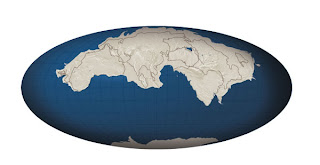Spoiler Alert! Spoiler Alert!
Don’t Read On If You Don’t Want To Know The Ending
The Organic Act of 1916 established the National Park Service and in that piece of legislation the mission of the NPS was laid out: "...to promote and regulate the use of the...national parks...which purpose is to conserve the scenery and the natural and historic objects and the wild life therein and to provide for the enjoyment of the same in such manner and by such means as will leave them unimpaired for the enjoyment of future generations."
These words are the ruler by which we, as an Agency, measure our actions and direct our programs (most of the time). Nearly all our employees love the mission and most love both the mission and the organization. I do suspect that there are a few miscreant employees squirreled away who like neither.
Dinosaur National Monument was established in 1915 to preserve and protect dinosaur remains, making the Carnegie Quarry the specific site for which the Monument was created. Thus the QEH project to make a more stable building is crucial to Dinosaur meeting it mission. With the completion of the project we now have a building that will protect the fossil deposit far into the future. However, “… unimpaired for the enjoyment of future generations” means different things to different people and depends on your frame of reference. Einstein, in his laws of relativity, made it clear that there is no universal frame of reference and one must stipulate what the frame of reference is for any given measurement or observation. So let’s look at the fate of the NPS mission for the QEH and Carnegie Quarry from a perspective other than that of "future generation"... oh, say the frame of reference of Earth History.
Predicting Biological Systems
Predicting the long-term future of lineages of organisms is very, very difficult and probably impossible. For example, if you were wandering around the sea floor 550 million-years ago during the mid-Cambrian and looking at the Burgess Shale fauna composed of sponges, velvet worms, penis worms, primitive fish, trilobites, etc……… you would not predict that over the next several hundred million years these groups would diversify into tyrannosaurs, whales, tree frogs, aardvarks, rhinos, stegosaurs, dragonflies, bracket fungi, Venus fly traps, and so forth.
Your failure would not be one of lack of imagination. Rather, it has to do with the nucleic acids that make up our chromosomes and genes. The mere process of replication of hereditary material during cell growth and division creates new genetic combinations and arrangements. Individual genes mutate, offering additional genetic diversity. Once sexual reproduction evolved, the process of meiosis that produces gametes and the fertilization of eggs by sperm vastly increased genetic diversity. Every progeny is, in a sense, a roll of the dice with different genetic composition upon which natural selection can work. Given all these sources of variation and the various ways that natural selection can cause differential survival in any generation, one simply cannot make long term predictions about how a lineage of organisms will evolve or even if it will survive, or go extinct. There are few “natural laws” of broad application in biological systems.
The Physical Side of Things
In contrast to living systems, physical systems are more subject to forces that can be determined, quantified, and used to make predictions. That is why one can predict the trajectory of munitions, the orbital path of a moon, planet, solar system, or galaxy with some precision. In general, laws ruling the physical world are more common than those in biological systems and have more predictive power. “Yes, yes” you say, “how very interesting and clever. You’re a regular geological Noel Coward. But what the hell, may I politely ask, does this have to do with the QEH and the mission of the NPS?” Well let’s have a look.
The Fate of the Carnegie Quarry and the QEH
By way of starting, let’s look at our location. Our solar system sits on the Sagittarius arm of the Milky Way Galaxy of the local cluster, about half way out from the galactic center.
Now that we are oriented, what lies ahead? In the following, all years are years in the future.
100 million years Based on what we know of the history and pattern of meteorite, comet, and asteroid impacts of Earth and the solar system, by this time Earth will be have been struck by an extraterrestrial object of the size that killed the dinosaurs and caused the Cretaceous global extinction event.
250 million years Following current patterns of plate tectonics and continental drift, nearly all the continents on Earth fuse into a new supercontinent, completing the latest supercontinent cycle.
600 million years The increasing surface temperature of the Sun causes increased weathering of rocks on Earth, resulting in decreasing atmospheric levels of carbon dioxide. At 600 millions years these levels will be so low that C3 photosynthesis in plants will become impossible. Since approximately 99% of the living plants species use the C3 photosynthetic pathway, the result of these changes will be a catastrophic plant extinction.
800 million years Decreasing levels of atmospheric carbon dioxide drop to levels where C4 photosynthesis is no longer possible, resulting in the extinction of all plants that avoided the 600 million year extinction event. Since plants produce oxygen as a by product of photosynthesis, atmospheric free oxygen will eventually disappear.
1 billion years. The luminosity of the Sun (i.e. the amount of light emitted) increases by about 10% every billion years. As a result the surface temperature of the Earth by this time will increase to 47oC (117oF) and all surface water, including the oceans, will begin to boil away. All terrestrial life will become extinct.
3.5 billion years Earth has become a run away greenhouse and its surface conditions will resemble those of present day Venus with a temperature of 460°C (860°F).
5 billion years Driven by the laws of physics, astronomers can predict the “life history” of a star based on the star’s original mass. It is a widespread misconception that every star will become a supernova and explode. Not true. Our Sun is only 1/6 the mass needed to become a supernova and such is definitely not in its future. However, that turns out to be of little consolation.
When the hydrogen fuel in the Sun’s core is consumed, the core contracts and heats up. Eventually the Sun will begin to expand and enters its red giant phase. As the size of the Sun grows, it will expand beyond the orbit of Mercury and Venus and both those planets will be consumed.
What happens to the Earth is a little less clear because our orbit is in the area of maximum expansion of the red giant Sun. However, even if the Earth is not consumed by the Sun, Earth’s temperature will become so great that our planet’s surface will melt.
Two excellent short videos on the red giant Sun and its impact on the solar system are
Solar Empire: Death of the Sun
http://videos.howstuffworks.com/tlc/28850-solar-empire-death-of-the-sun-video.htm
The Future of our Sun
http://www.youtube.com/watch?v=qpMRtvFD8ek
This one is a bit longer but nicely shows the internal evolution of the Sun that results in it becoming a red giant.
7 billion years Our Milky Way galaxy collides with the Andromeda galaxy. Such galactic collisions are not unusual and our galaxy is currently colliding with two dwarf galaxies. The implications for Earth of a collision with the Andromeda galaxy are uncertain, but photos taken by the Hubble telescope show that galactic collisions are usually nasty affairs.
 |
7.5 billion years After the Sun throws off its outer layers at the end of its Red Giant phase and with only the hot core is left it becomes a white dwarf. White dwarfs are extremely dense, with the mass of the Sun in the volume of our Earth. However, its light comes just from stored thermal energy rather than fusion and it will ultimately cool further with time. Our Sun will become nothing more than a faint spot of light, a mere shadow of its former self.
So THIS is the future of the Carnegie Quarry and the Quarry Exhibit Hall. While there are different timelines for these events, the ultimate fate our our Sun, and hence the Carnegie Quarry, is unavoidable. Our Sun’s future is typical of that of low to medium mass stars.
And don’t think about running to Mars during the Red Giant stage, because while Mars will warm up and its ice will melt, it will continue warming and become uninhabitable. Both Jupiter and Saturn are gas giants, with only small rocky cores and will never become habitable even if much of their immense, thick atmospheres are lost. It’s possible that some of the moons of Jupiter might have a remote chance of becoming habitable during the red giant stage but that’s unlikely. But even if that was so, and even is we could move to those moons, I doubt that we have the wherewithal to cut up the Carnegie Quarry sandstone and bones and haul it with us. By the way, forget about black hole generated wormholes as ways of jumping to distant parts of the galaxy. It seems that even if one could manage to successfully navigate through a wormhole, what would come out the other side would retain your mass and momentum but not in any form like that when you went in.
When I point this out this future history of the Carnegie Quarry to dedicated NPS employees, virtually all of them express the view of so what, humans won’t be around even a thousand years in the future, much less the amounts of time we are talking about here. I hold the same view but, as I wrote above, predicting what biological organisms and systems will do is difficult, so we don’t know for sure. However, the future history of our planet in inevitable and inescapable. As Darwin wrote in the opening sentence of the last paragraph of The Origin of Species “There is grandeur in this view of life….” and I quite agree --- even as it applies to our solar system’s demise.
I only have a decade or two left to wander on the third rock from the Sun and yet I’ve spent a bit of time over the last few years to ensure, even knowing the ultimate outcome, that the new buildings and exhibits will function and protect the wall of bones. While the fate of the Carnegie Quarry maybe of no importance to the Universe, it should be of importance to us. I assume that you, constant reader, agree. Otherwise why would you have followed me over the last 100+ postings here?
For those of you interested in following the future of the Universe beyond the 7.5 billion years covered here, I suggest making a first stop at the Time Line of the Future (1). The information is provided in a helpful table format. But beware --- there are some mighty big numbers out there and some very strange events yet to occur! A nice introduction to our Sun, how it works, and its future can be found at (2)
References
(1)Timeline of the far future http://en.wikipedia.org/wiki/Timeline_of_the_far_future(2) The Sun http://en.wikipedia.org/wiki/Sun
Images (in order of appearance)
Burgess Shale http://green-enb150.blogspot.com/2011/04/burgess-shale.htmlAardvark http://www.zooborns.typepad.com/zooborns/aardvark/
Venus fly trap http://www.cooltropicalplants.com/Venus-fly-traps.html
Circular Orbits http://lasp.colorado.edu/~bagenal/3750/ClassNotes/Class2/Class2.html
Sun in our galaxy http://en.wikipedia.org/wiki/File:236084main_MilkyWay-full-annotated.jpg
Asteroid impact http://www.fallingstar.wo.to/act3.htm
Supercontinent http://environment.newscientist.com/data/images/ns/av/mg19626261V1/mg19626261V1.html
Earth's greenhouse atmosphere http://astroguyz.com/2009/04/01/april-2009-news-notes/
Life cycle of Sun http://en.wikipedia.org/wiki/Sun
http://www.michaelh53.com/astronomy/eotwdetail.htm
Earth and red giant Sun
http://www.kiwispaceplace.com/astronomy-guide-dead-stars.html
Galactic collisions
http://scienceblogs.com/startswithabang/upload/2011/07/what_our_future_looks_like_to/heic0810ac.jpeg
White dwarf Sun
http://www.physics.uc.edu/~hanson/ASTRO/LECTURENOTES/W02/Lec9/Page1.html












No comments:
Post a Comment